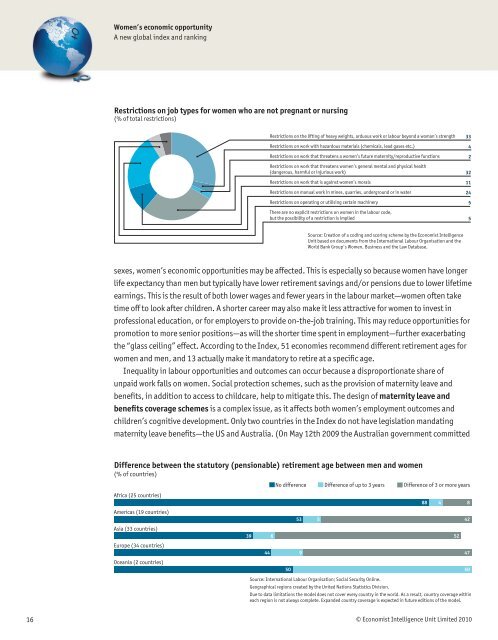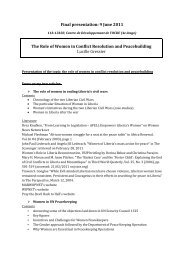Women's Economic Opportunity Index - Economist Intelligence Unit
Women's Economic Opportunity Index - Economist Intelligence Unit
Women's Economic Opportunity Index - Economist Intelligence Unit
- No tags were found...
You also want an ePaper? Increase the reach of your titles
YUMPU automatically turns print PDFs into web optimized ePapers that Google loves.
Women’s economic opportunityA new global index and rankingRestrictions on job types for women who are not pregnant or nursing(% of total restrictions)Restrictions on the lifting of heavy weights, arduous work or labour beyond a woman’s strengthRestrictions on work with hazardous materials (chemicals, lead gases etc.)Restrictions on work that threatens a women’s future maternity/reproductive functionsRestrictions on work that threatens women’s general mental and physical health(dangerous, harmful or injurious work)Restrictions on work that is against women’s moralsRestrictions on manual work in mines, quarries, underground or in waterRestrictions on operating or utilising certain machineryThere are no explicit restrictions on women in the labour code,but the possibility of a restriction is implied334232112455Source: Creation of a coding and scoring scheme by the <strong>Economist</strong> <strong>Intelligence</strong><strong>Unit</strong> based on documents from the International Labour Organisation and theWorld Bank Group's Women, Business and the Law Database.sexes, women’s economic opportunities may be affected. This is especially so because women have longerlife expectancy than men but typically have lower retirement savings and/or pensions due to lower lifetimeearnings. This is the result of both lower wages and fewer years in the labour market—women often taketime off to look after children. A shorter career may also make it less attractive for women to invest inprofessional education, or for employers to provide on-the-job training. This may reduce opportunities forpromotion to more senior positions—as will the shorter time spent in employment—further exacerbatingthe “glass ceiling” effect. According to the <strong>Index</strong>, 51 economies recommend different retirement ages forwomen and men, and 13 actually make it mandatory to retire at a specific age.Inequality in labour opportunities and outcomes can occur because a disproportionate share ofunpaid work falls on women. Social protection schemes, such as the provision of maternity leave andbenefits, in addition to access to childcare, help to mitigate this. The design of maternity leave andbenefits coverage schemes is a complex issue, as it affects both women’s employment outcomes andchildren’s cognitive development. Only two countries in the <strong>Index</strong> do not have legislation mandatingmaternity leave benefits—the US and Australia. (On May 12th 2009 the Australian government committedDifference between the statutory (pensionable) retirement age between men and women(% of countries)Africa (25 countries)Americas (19 countries)Asia (33 countries)Europe (34 countries)Oceania (2 countries)No difference Difference of up to 3 years Difference of 3 or more years88 4 853 5 4239 6 5244 9 4750 50Source: International Labour Organisation; Social Security Online.Geographical regions created by the <strong>Unit</strong>ed Nations Statistics Division.Due to data limitations the model does not cover every country in the world. As a result, country coverage withineach region is not always complete. Expanded country coverage is expected in future editions of the model.0 20 40 60 80 10016© <strong>Economist</strong> <strong>Intelligence</strong> <strong>Unit</strong> Limited 2010




